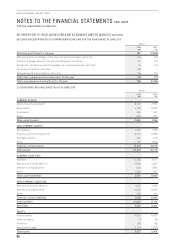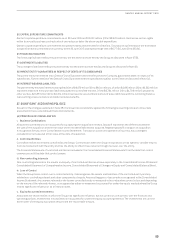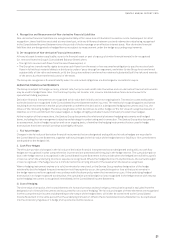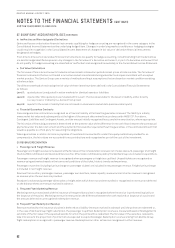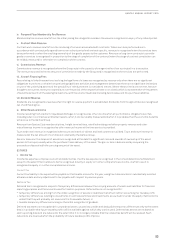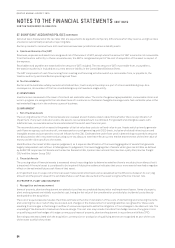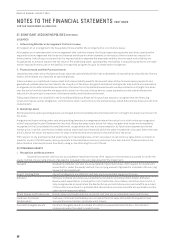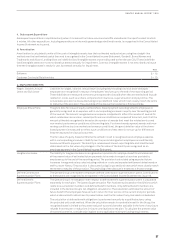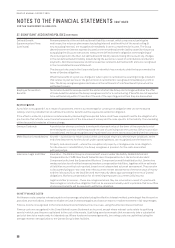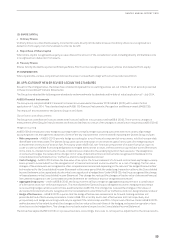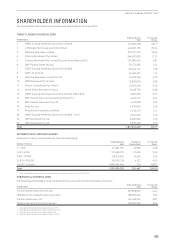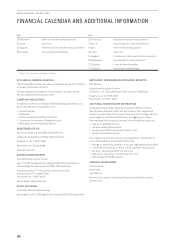Qantas 2015 Annual Report Download - page 99
Download and view the complete annual report
Please find page 99 of the 2015 Qantas annual report below. You can navigate through the pages in the report by either clicking on the pages listed below, or by using the keyword search tool below to find specific information within the annual report.
NOTES TO THE FINANCIAL STATEMENTS CONTINUED
FOR THE YEAR ENDED 30 JUNE 2015
98
QANTAS ANNUAL REPORT 2015
Defined Benefit
Superannuation Plans
(continued)
Remeasurements of the net defined benefit liability or asset, which comprise actuarial gains
and losses, the return on plan assets (excluding interest) and the effect of the asset ceiling (if
any, excluding interest), are recognised immediately in other comprehensive income. The Group
determines the net interest expense (income) on the net defined benefit liability (asset) for the period
by applying the discount rate used to measure the defined benefit obligation at the beginning of
the annual period to the then-net defined benefit liability (asset), taking into account any changes
in the net defined benefit liability (asset) during the period as a result of contributions and benefit
payments. Net interest expense and other expenses related to defined benefit plans are recognised
in the Consolidated Income Statement.
The discount rate used is the Corporate Bond rate which has a maturity date that approximates the
terms of Qantas obligations.
When the benefits of a plan are changed or when a plan is curtailed, the resulting change in benefit
that relates to past service or the gain or loss on curtailment is recognised immediately in profit or
loss. The Group recognises gains and losses on the settlement of a defined benefit plan when the
settlement occurs.
Employee Termination
Benefits
Termination benefits are expensed at the earlier of when the Group can no longer withdraw the offer
ofthose benefits and when the Group recognises costs for a restructuring. If benefits are not expected
to be settled wholly within 12 months of the end of the reporting period, then they are discounted.
M OV IONS
A provision is recognised if, as a result of a past event, there is a present legal or constructive obligation that can be measured
reliably, and it is probable that an outflow of economic benefits will be required to settle the obligation.
If the effect is material, a provision is determined by discounting the expected future cash flows required to settle the obligation at a
pre-tax rate that reflects current market assessments of the time value of money and the risks specific to the liability. The unwinding
of the discount is treated as a finance charge.
Onerous Contracts A provision for onerous contracts is measured at present value of the lower of the expected cost of
terminating the contract and the expected net cost of continuing with the contract. Before a provision
is established, the Group recognises any impairment loss on the assets associated with that contract.
Make Good on Leased Assets Aircraft – a provision for return costs to meet contractual return aircraft minimum conditions, at the
end of the lease terms for the aircraft under operating leases, are recognised over the lease term.
Property and environment – where the occupation of property or land gives rise to an obligation
for site closure or rehabilitation, the Group recognises a provision for the costs associated
withrestoration.
Insurance, Legal and Other Insurance – the Qantas Group is a licenced self-insurer under the Safety, Rehabilitation and
Compensation Act 1988, New South Wales Workers Compensation Act, the Victorian Accident
Compensation Act and the Queensland Workers’ Compensation and Rehabilitation Act. Qantas has
made provision for all notified assessed workers compensation liabilities, together with an estimate
of liabilities incurred but not reported, based on an independent actuarial assessment. The provision
is discounted using pre-tax rates that reflect current market assessments of the time value of money
and the risks specific to the liabilities and have maturity dates approximating the terms of Qantas’
obligations. Workers compensation for all remaining employees is commercially insured.
Legal and other provisions – these are recognised where they are incurred as a result of a past event,
there is legal or constructive obligation that can be measured reliably and it is probable that an outflow
of economic benefits will be required to settle the obligation.
(N) NET FINANCE COSTS
Net finance costs comprise interest payable on borrowings calculated using the effective interest method, unwinding of the discount on
provisions and receivables, interest receivable on funds invested and gains and losses on mark-to-market movement in fair value hedges.
Finance income is recognised in the Consolidated Income Statement as it accrues, using the effective interest method.
Finance costs are recognised in the Consolidated Income Statement as incurred, except where interest costs relate to qualifying
assets in which case they are capitalised to the cost of the assets. Qualifying assets are assets that necessarily take a substantial
period of time to be made ready for intended use. Where funds are borrowed generally, borrowing costs are capitalised using the
average interest rate applicable to the Qantas Group’s debt facilities.
37. SIGNIFICANT ACCOUNTING POLICIES CONTINUED


